Understanding and Leading Change: Next Plc Analysis Report
VerifiedAdded on 2023/01/19
|17
|5467
|22
Report
AI Summary
This report provides a comprehensive analysis of change management within Next Plc, a British multinational clothing and home products retailer. It explores the concept of organizational change and its significance in today's dynamic market. The report examines the internal and external drivers of change, including technological advancements, economic factors, and social trends, and their impact on the company's strategies, operations, and employee behavior. It analyzes the specific changes implemented by Next Plc and Topshop, focusing on technological updates, organizational restructuring, and strategic adaptations. The report further discusses the Burke-Litwin model, a framework for understanding organizational change, and its application in the context of Next Plc. It also identifies potential barriers to change and their impact on leadership decision-making. The report concludes by summarizing key findings and emphasizing the importance of effective change management for organizational success. The report covers different aspects like leadership approaches, individual and team behavior in context of organizational change.
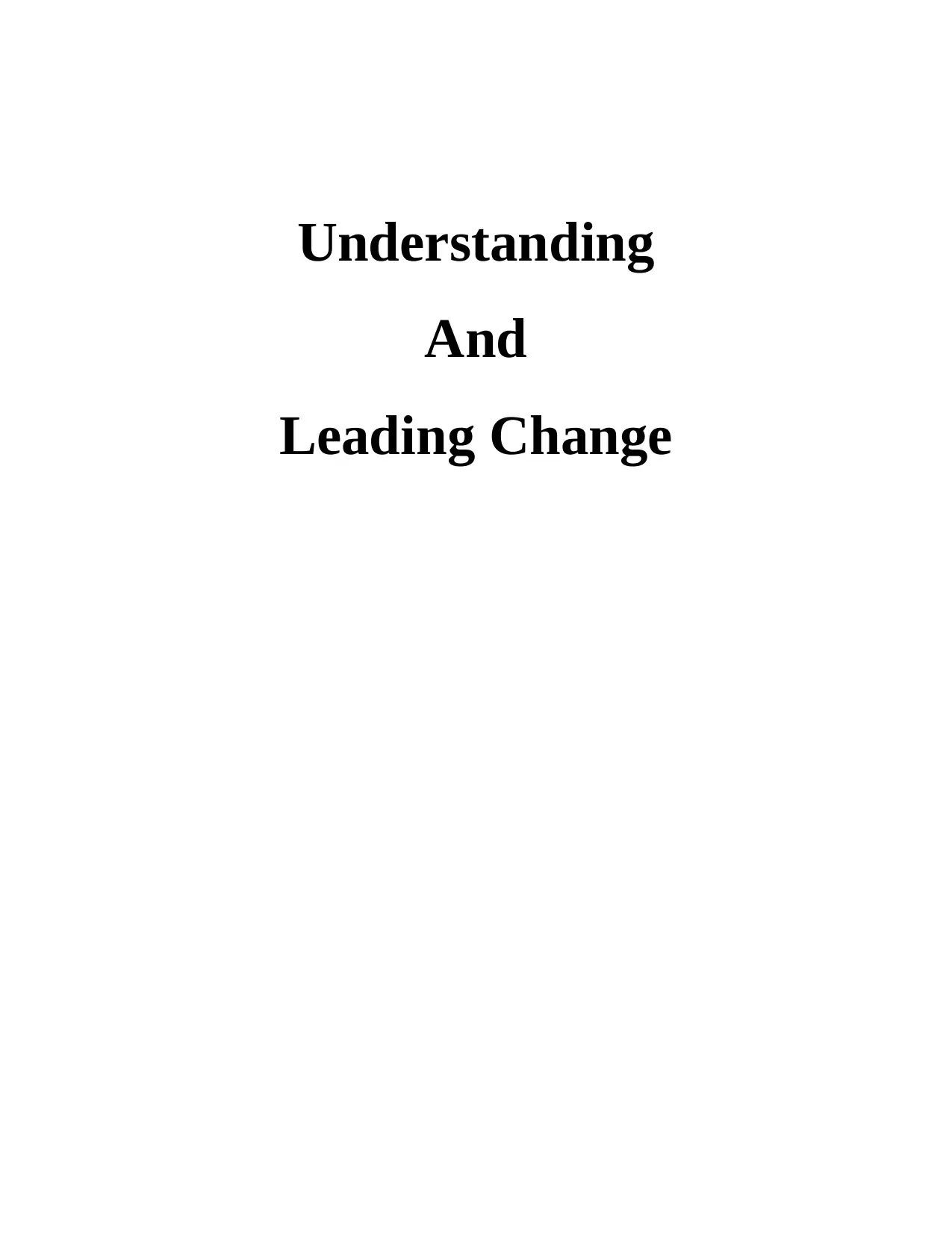
Understanding
And
Leading Change
And
Leading Change
Paraphrase This Document
Need a fresh take? Get an instant paraphrase of this document with our AI Paraphraser
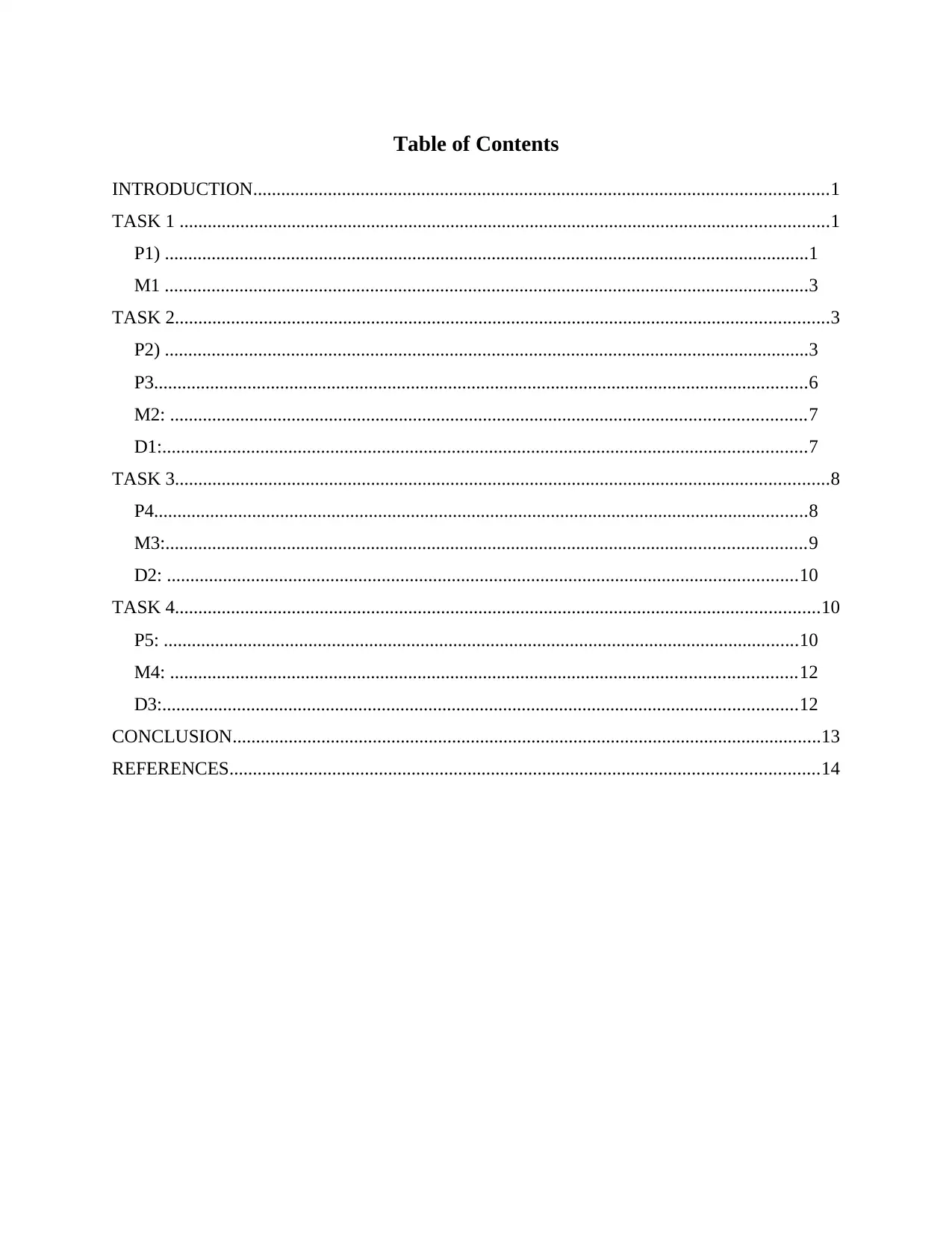
Table of Contents
INTRODUCTION...........................................................................................................................1
TASK 1 ...........................................................................................................................................1
P1) ..........................................................................................................................................1
M1 ..........................................................................................................................................3
TASK 2............................................................................................................................................3
P2) ..........................................................................................................................................3
P3............................................................................................................................................6
M2: ........................................................................................................................................7
D1:..........................................................................................................................................7
TASK 3............................................................................................................................................8
P4............................................................................................................................................8
M3:.........................................................................................................................................9
D2: .......................................................................................................................................10
TASK 4..........................................................................................................................................10
P5: ........................................................................................................................................10
M4: ......................................................................................................................................12
D3:........................................................................................................................................12
CONCLUSION..............................................................................................................................13
REFERENCES..............................................................................................................................14
INTRODUCTION...........................................................................................................................1
TASK 1 ...........................................................................................................................................1
P1) ..........................................................................................................................................1
M1 ..........................................................................................................................................3
TASK 2............................................................................................................................................3
P2) ..........................................................................................................................................3
P3............................................................................................................................................6
M2: ........................................................................................................................................7
D1:..........................................................................................................................................7
TASK 3............................................................................................................................................8
P4............................................................................................................................................8
M3:.........................................................................................................................................9
D2: .......................................................................................................................................10
TASK 4..........................................................................................................................................10
P5: ........................................................................................................................................10
M4: ......................................................................................................................................12
D3:........................................................................................................................................12
CONCLUSION..............................................................................................................................13
REFERENCES..............................................................................................................................14
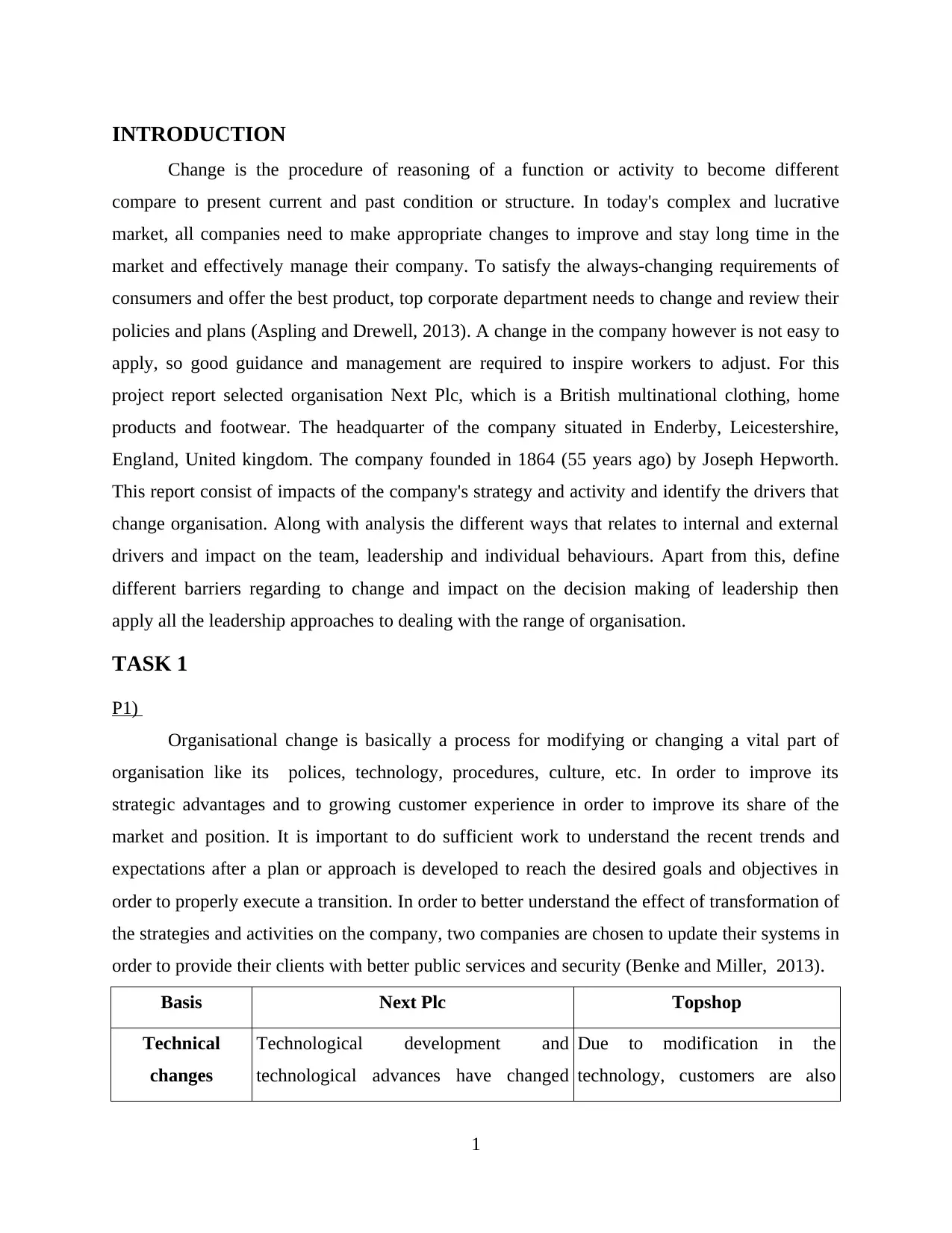
INTRODUCTION
Change is the procedure of reasoning of a function or activity to become different
compare to present current and past condition or structure. In today's complex and lucrative
market, all companies need to make appropriate changes to improve and stay long time in the
market and effectively manage their company. To satisfy the always-changing requirements of
consumers and offer the best product, top corporate department needs to change and review their
policies and plans (Aspling and Drewell, 2013). A change in the company however is not easy to
apply, so good guidance and management are required to inspire workers to adjust. For this
project report selected organisation Next Plc, which is a British multinational clothing, home
products and footwear. The headquarter of the company situated in Enderby, Leicestershire,
England, United kingdom. The company founded in 1864 (55 years ago) by Joseph Hepworth.
This report consist of impacts of the company's strategy and activity and identify the drivers that
change organisation. Along with analysis the different ways that relates to internal and external
drivers and impact on the team, leadership and individual behaviours. Apart from this, define
different barriers regarding to change and impact on the decision making of leadership then
apply all the leadership approaches to dealing with the range of organisation.
TASK 1
P1)
Organisational change is basically a process for modifying or changing a vital part of
organisation like its polices, technology, procedures, culture, etc. In order to improve its
strategic advantages and to growing customer experience in order to improve its share of the
market and position. It is important to do sufficient work to understand the recent trends and
expectations after a plan or approach is developed to reach the desired goals and objectives in
order to properly execute a transition. In order to better understand the effect of transformation of
the strategies and activities on the company, two companies are chosen to update their systems in
order to provide their clients with better public services and security (Benke and Miller, 2013).
Basis Next Plc Topshop
Technical
changes
Technological development and
technological advances have changed
Due to modification in the
technology, customers are also
1
Change is the procedure of reasoning of a function or activity to become different
compare to present current and past condition or structure. In today's complex and lucrative
market, all companies need to make appropriate changes to improve and stay long time in the
market and effectively manage their company. To satisfy the always-changing requirements of
consumers and offer the best product, top corporate department needs to change and review their
policies and plans (Aspling and Drewell, 2013). A change in the company however is not easy to
apply, so good guidance and management are required to inspire workers to adjust. For this
project report selected organisation Next Plc, which is a British multinational clothing, home
products and footwear. The headquarter of the company situated in Enderby, Leicestershire,
England, United kingdom. The company founded in 1864 (55 years ago) by Joseph Hepworth.
This report consist of impacts of the company's strategy and activity and identify the drivers that
change organisation. Along with analysis the different ways that relates to internal and external
drivers and impact on the team, leadership and individual behaviours. Apart from this, define
different barriers regarding to change and impact on the decision making of leadership then
apply all the leadership approaches to dealing with the range of organisation.
TASK 1
P1)
Organisational change is basically a process for modifying or changing a vital part of
organisation like its polices, technology, procedures, culture, etc. In order to improve its
strategic advantages and to growing customer experience in order to improve its share of the
market and position. It is important to do sufficient work to understand the recent trends and
expectations after a plan or approach is developed to reach the desired goals and objectives in
order to properly execute a transition. In order to better understand the effect of transformation of
the strategies and activities on the company, two companies are chosen to update their systems in
order to provide their clients with better public services and security (Benke and Miller, 2013).
Basis Next Plc Topshop
Technical
changes
Technological development and
technological advances have changed
Due to modification in the
technology, customers are also
1
⊘ This is a preview!⊘
Do you want full access?
Subscribe today to unlock all pages.

Trusted by 1+ million students worldwide
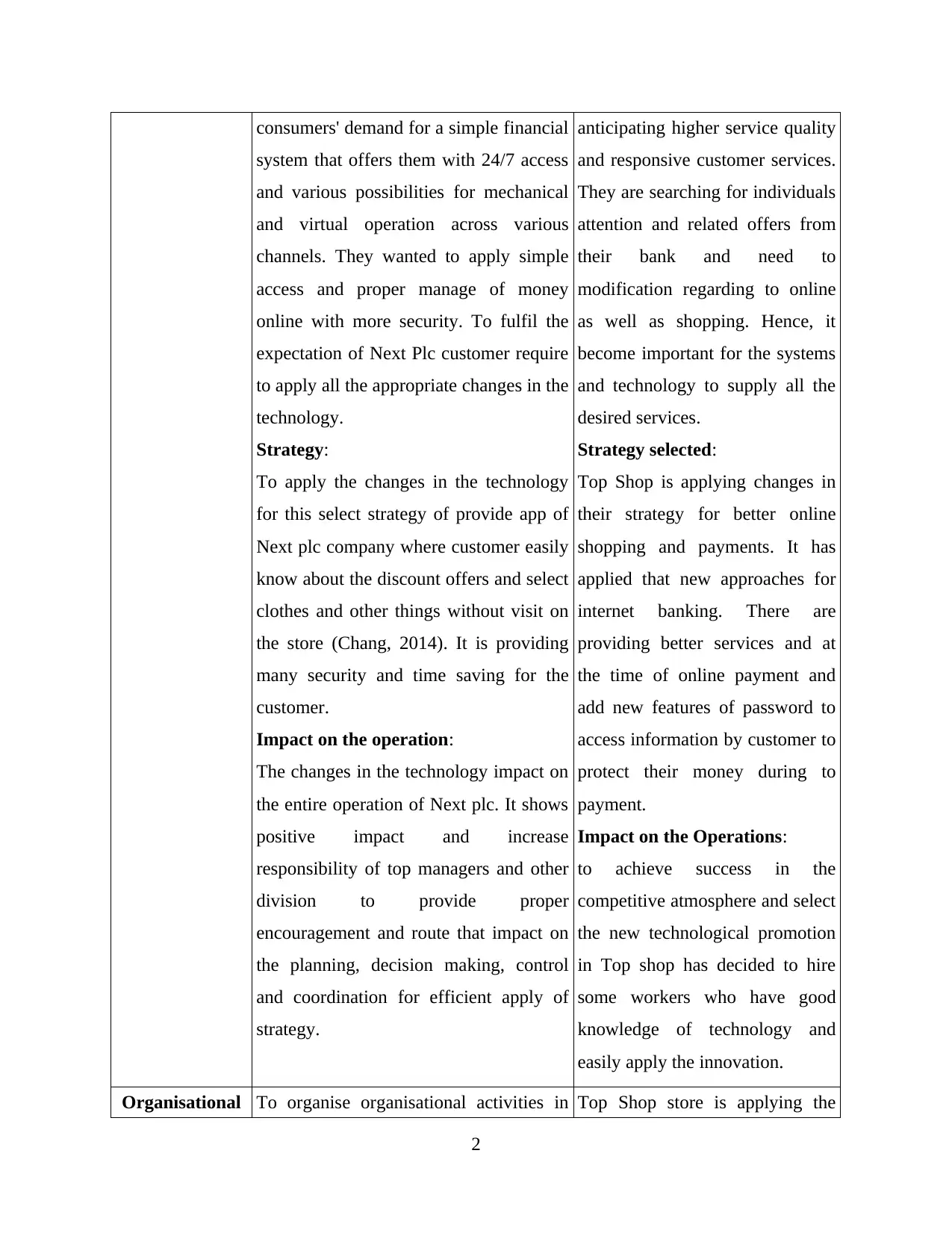
consumers' demand for a simple financial
system that offers them with 24/7 access
and various possibilities for mechanical
and virtual operation across various
channels. They wanted to apply simple
access and proper manage of money
online with more security. To fulfil the
expectation of Next Plc customer require
to apply all the appropriate changes in the
technology.
Strategy:
To apply the changes in the technology
for this select strategy of provide app of
Next plc company where customer easily
know about the discount offers and select
clothes and other things without visit on
the store (Chang, 2014). It is providing
many security and time saving for the
customer.
Impact on the operation:
The changes in the technology impact on
the entire operation of Next plc. It shows
positive impact and increase
responsibility of top managers and other
division to provide proper
encouragement and route that impact on
the planning, decision making, control
and coordination for efficient apply of
strategy.
anticipating higher service quality
and responsive customer services.
They are searching for individuals
attention and related offers from
their bank and need to
modification regarding to online
as well as shopping. Hence, it
become important for the systems
and technology to supply all the
desired services.
Strategy selected:
Top Shop is applying changes in
their strategy for better online
shopping and payments. It has
applied that new approaches for
internet banking. There are
providing better services and at
the time of online payment and
add new features of password to
access information by customer to
protect their money during to
payment.
Impact on the Operations:
to achieve success in the
competitive atmosphere and select
the new technological promotion
in Top shop has decided to hire
some workers who have good
knowledge of technology and
easily apply the innovation.
Organisational To organise organisational activities in Top Shop store is applying the
2
system that offers them with 24/7 access
and various possibilities for mechanical
and virtual operation across various
channels. They wanted to apply simple
access and proper manage of money
online with more security. To fulfil the
expectation of Next Plc customer require
to apply all the appropriate changes in the
technology.
Strategy:
To apply the changes in the technology
for this select strategy of provide app of
Next plc company where customer easily
know about the discount offers and select
clothes and other things without visit on
the store (Chang, 2014). It is providing
many security and time saving for the
customer.
Impact on the operation:
The changes in the technology impact on
the entire operation of Next plc. It shows
positive impact and increase
responsibility of top managers and other
division to provide proper
encouragement and route that impact on
the planning, decision making, control
and coordination for efficient apply of
strategy.
anticipating higher service quality
and responsive customer services.
They are searching for individuals
attention and related offers from
their bank and need to
modification regarding to online
as well as shopping. Hence, it
become important for the systems
and technology to supply all the
desired services.
Strategy selected:
Top Shop is applying changes in
their strategy for better online
shopping and payments. It has
applied that new approaches for
internet banking. There are
providing better services and at
the time of online payment and
add new features of password to
access information by customer to
protect their money during to
payment.
Impact on the Operations:
to achieve success in the
competitive atmosphere and select
the new technological promotion
in Top shop has decided to hire
some workers who have good
knowledge of technology and
easily apply the innovation.
Organisational To organise organisational activities in Top Shop store is applying the
2
Paraphrase This Document
Need a fresh take? Get an instant paraphrase of this document with our AI Paraphraser
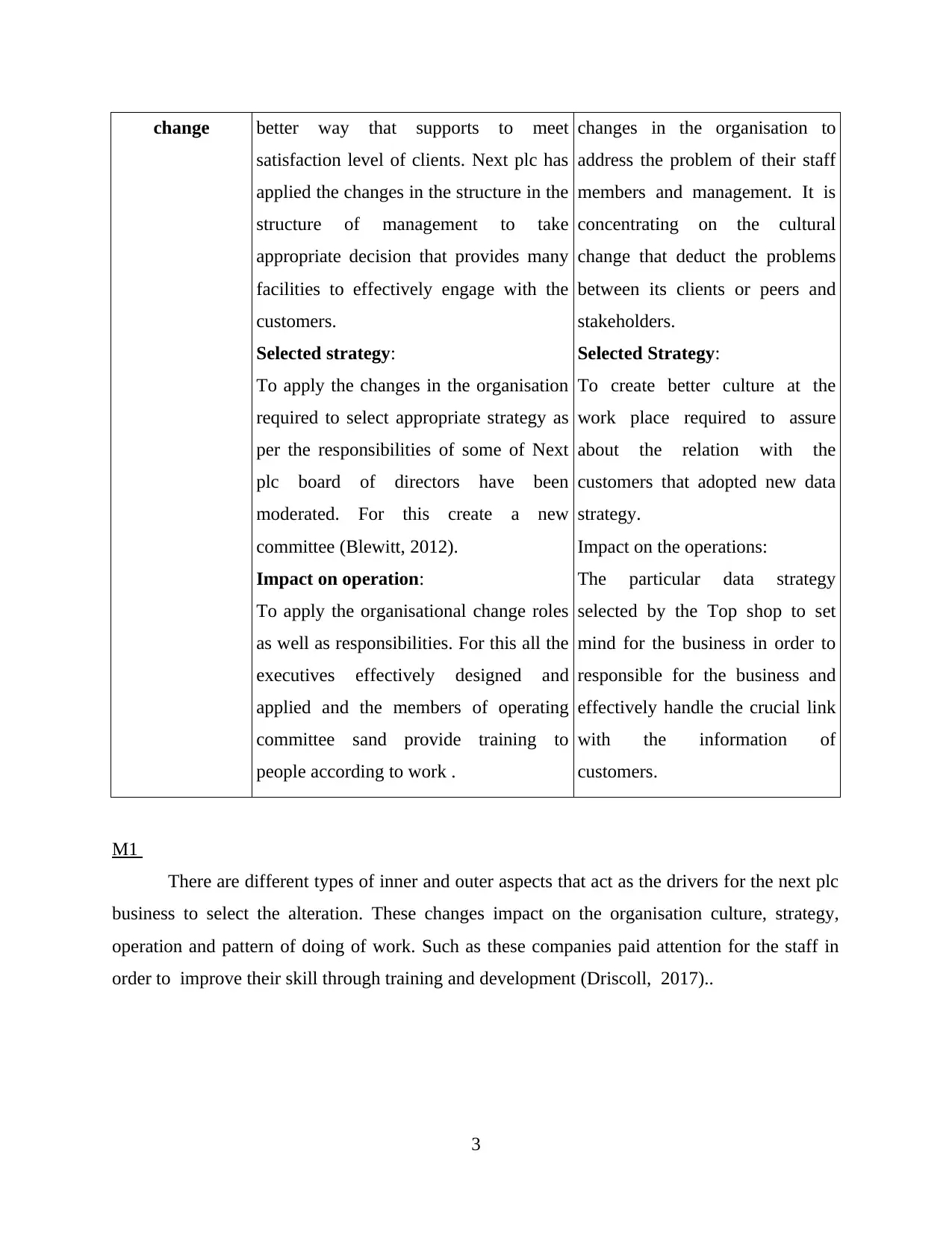
change better way that supports to meet
satisfaction level of clients. Next plc has
applied the changes in the structure in the
structure of management to take
appropriate decision that provides many
facilities to effectively engage with the
customers.
Selected strategy:
To apply the changes in the organisation
required to select appropriate strategy as
per the responsibilities of some of Next
plc board of directors have been
moderated. For this create a new
committee (Blewitt, 2012).
Impact on operation:
To apply the organisational change roles
as well as responsibilities. For this all the
executives effectively designed and
applied and the members of operating
committee sand provide training to
people according to work .
changes in the organisation to
address the problem of their staff
members and management. It is
concentrating on the cultural
change that deduct the problems
between its clients or peers and
stakeholders.
Selected Strategy:
To create better culture at the
work place required to assure
about the relation with the
customers that adopted new data
strategy.
Impact on the operations:
The particular data strategy
selected by the Top shop to set
mind for the business in order to
responsible for the business and
effectively handle the crucial link
with the information of
customers.
M1
There are different types of inner and outer aspects that act as the drivers for the next plc
business to select the alteration. These changes impact on the organisation culture, strategy,
operation and pattern of doing of work. Such as these companies paid attention for the staff in
order to improve their skill through training and development (Driscoll, 2017)..
3
satisfaction level of clients. Next plc has
applied the changes in the structure in the
structure of management to take
appropriate decision that provides many
facilities to effectively engage with the
customers.
Selected strategy:
To apply the changes in the organisation
required to select appropriate strategy as
per the responsibilities of some of Next
plc board of directors have been
moderated. For this create a new
committee (Blewitt, 2012).
Impact on operation:
To apply the organisational change roles
as well as responsibilities. For this all the
executives effectively designed and
applied and the members of operating
committee sand provide training to
people according to work .
changes in the organisation to
address the problem of their staff
members and management. It is
concentrating on the cultural
change that deduct the problems
between its clients or peers and
stakeholders.
Selected Strategy:
To create better culture at the
work place required to assure
about the relation with the
customers that adopted new data
strategy.
Impact on the operations:
The particular data strategy
selected by the Top shop to set
mind for the business in order to
responsible for the business and
effectively handle the crucial link
with the information of
customers.
M1
There are different types of inner and outer aspects that act as the drivers for the next plc
business to select the alteration. These changes impact on the organisation culture, strategy,
operation and pattern of doing of work. Such as these companies paid attention for the staff in
order to improve their skill through training and development (Driscoll, 2017)..
3
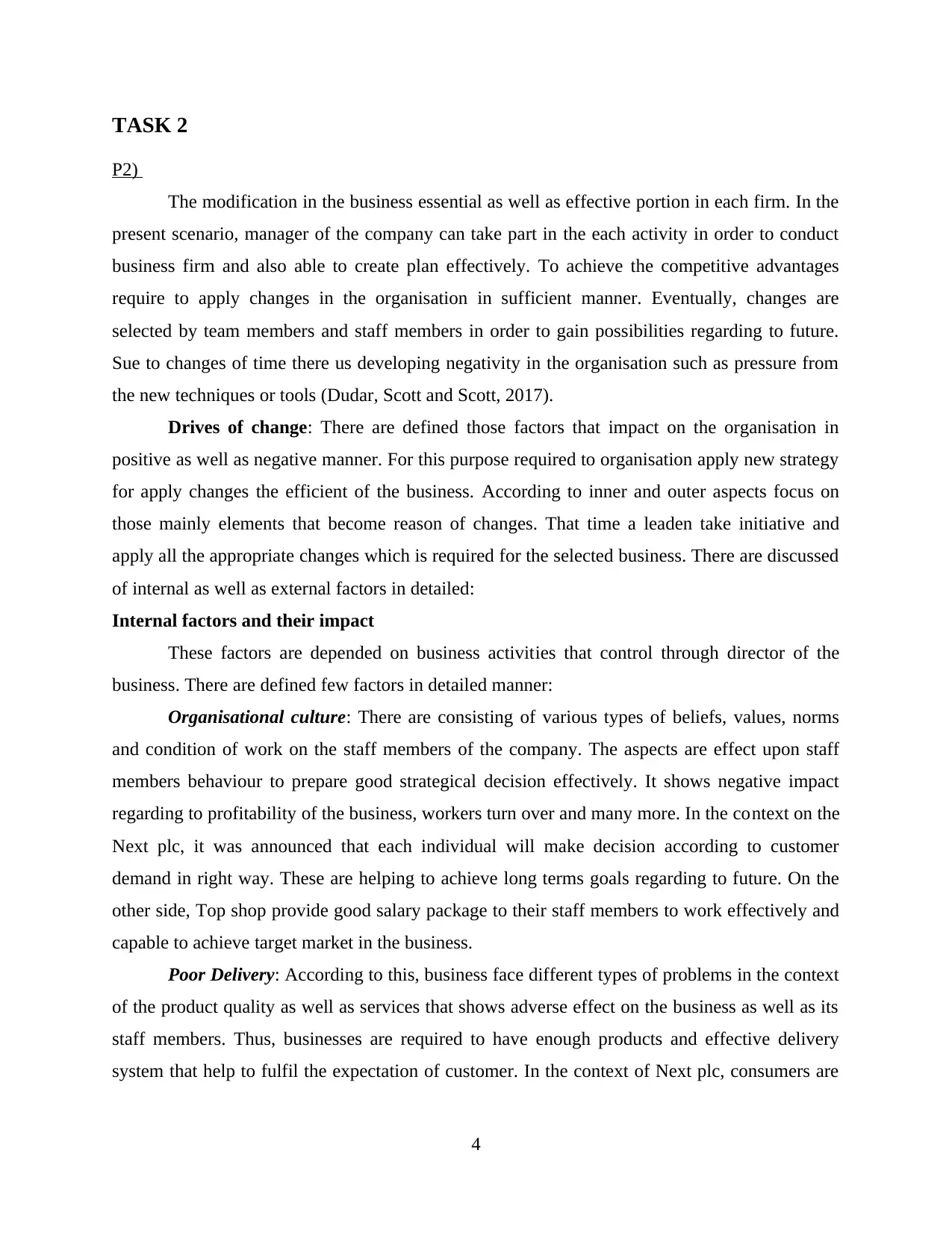
TASK 2
P2)
The modification in the business essential as well as effective portion in each firm. In the
present scenario, manager of the company can take part in the each activity in order to conduct
business firm and also able to create plan effectively. To achieve the competitive advantages
require to apply changes in the organisation in sufficient manner. Eventually, changes are
selected by team members and staff members in order to gain possibilities regarding to future.
Sue to changes of time there us developing negativity in the organisation such as pressure from
the new techniques or tools (Dudar, Scott and Scott, 2017).
Drives of change: There are defined those factors that impact on the organisation in
positive as well as negative manner. For this purpose required to organisation apply new strategy
for apply changes the efficient of the business. According to inner and outer aspects focus on
those mainly elements that become reason of changes. That time a leaden take initiative and
apply all the appropriate changes which is required for the selected business. There are discussed
of internal as well as external factors in detailed:
Internal factors and their impact
These factors are depended on business activities that control through director of the
business. There are defined few factors in detailed manner:
Organisational culture: There are consisting of various types of beliefs, values, norms
and condition of work on the staff members of the company. The aspects are effect upon staff
members behaviour to prepare good strategical decision effectively. It shows negative impact
regarding to profitability of the business, workers turn over and many more. In the context on the
Next plc, it was announced that each individual will make decision according to customer
demand in right way. These are helping to achieve long terms goals regarding to future. On the
other side, Top shop provide good salary package to their staff members to work effectively and
capable to achieve target market in the business.
Poor Delivery: According to this, business face different types of problems in the context
of the product quality as well as services that shows adverse effect on the business as well as its
staff members. Thus, businesses are required to have enough products and effective delivery
system that help to fulfil the expectation of customer. In the context of Next plc, consumers are
4
P2)
The modification in the business essential as well as effective portion in each firm. In the
present scenario, manager of the company can take part in the each activity in order to conduct
business firm and also able to create plan effectively. To achieve the competitive advantages
require to apply changes in the organisation in sufficient manner. Eventually, changes are
selected by team members and staff members in order to gain possibilities regarding to future.
Sue to changes of time there us developing negativity in the organisation such as pressure from
the new techniques or tools (Dudar, Scott and Scott, 2017).
Drives of change: There are defined those factors that impact on the organisation in
positive as well as negative manner. For this purpose required to organisation apply new strategy
for apply changes the efficient of the business. According to inner and outer aspects focus on
those mainly elements that become reason of changes. That time a leaden take initiative and
apply all the appropriate changes which is required for the selected business. There are discussed
of internal as well as external factors in detailed:
Internal factors and their impact
These factors are depended on business activities that control through director of the
business. There are defined few factors in detailed manner:
Organisational culture: There are consisting of various types of beliefs, values, norms
and condition of work on the staff members of the company. The aspects are effect upon staff
members behaviour to prepare good strategical decision effectively. It shows negative impact
regarding to profitability of the business, workers turn over and many more. In the context on the
Next plc, it was announced that each individual will make decision according to customer
demand in right way. These are helping to achieve long terms goals regarding to future. On the
other side, Top shop provide good salary package to their staff members to work effectively and
capable to achieve target market in the business.
Poor Delivery: According to this, business face different types of problems in the context
of the product quality as well as services that shows adverse effect on the business as well as its
staff members. Thus, businesses are required to have enough products and effective delivery
system that help to fulfil the expectation of customer. In the context of Next plc, consumers are
4
⊘ This is a preview!⊘
Do you want full access?
Subscribe today to unlock all pages.

Trusted by 1+ million students worldwide
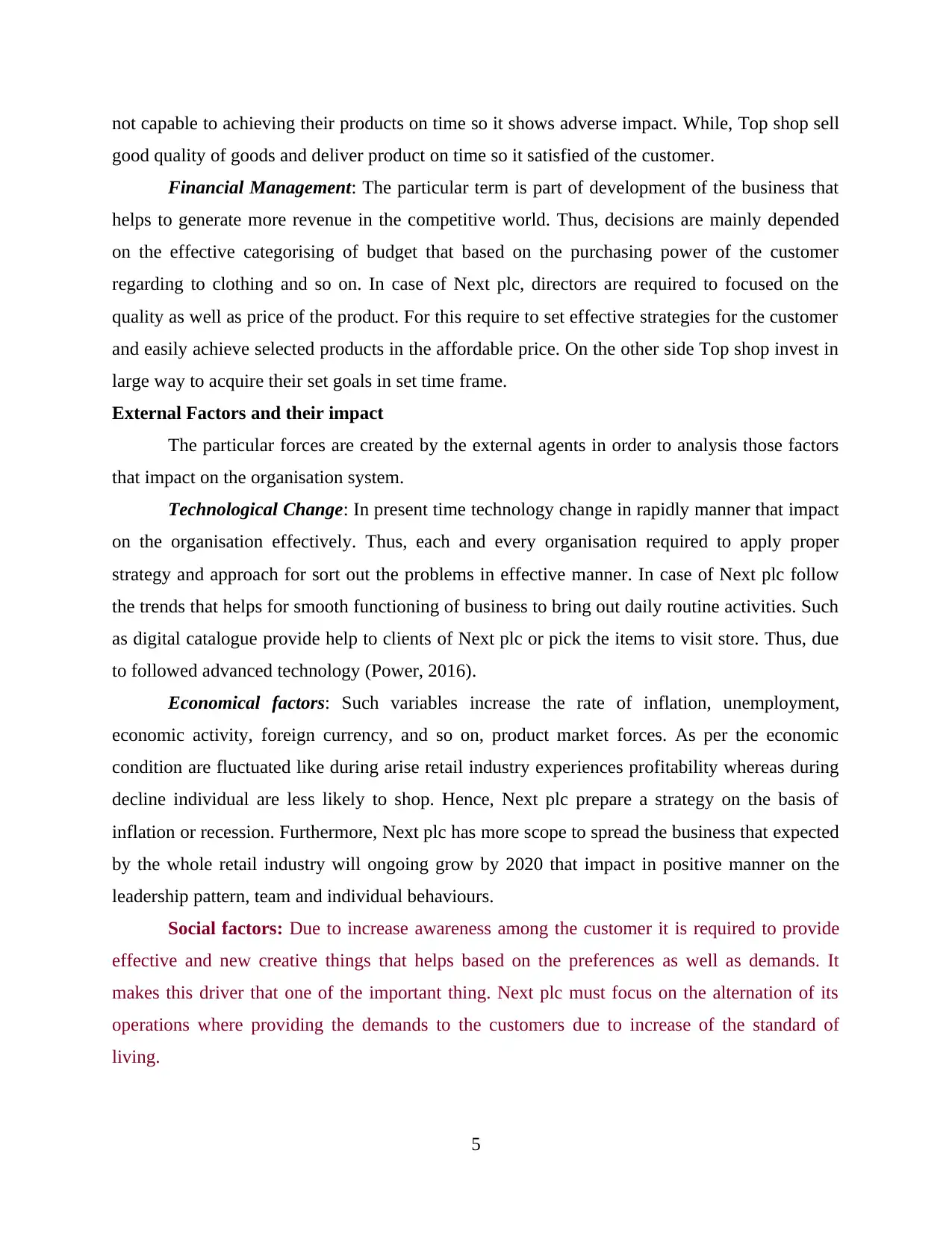
not capable to achieving their products on time so it shows adverse impact. While, Top shop sell
good quality of goods and deliver product on time so it satisfied of the customer.
Financial Management: The particular term is part of development of the business that
helps to generate more revenue in the competitive world. Thus, decisions are mainly depended
on the effective categorising of budget that based on the purchasing power of the customer
regarding to clothing and so on. In case of Next plc, directors are required to focused on the
quality as well as price of the product. For this require to set effective strategies for the customer
and easily achieve selected products in the affordable price. On the other side Top shop invest in
large way to acquire their set goals in set time frame.
External Factors and their impact
The particular forces are created by the external agents in order to analysis those factors
that impact on the organisation system.
Technological Change: In present time technology change in rapidly manner that impact
on the organisation effectively. Thus, each and every organisation required to apply proper
strategy and approach for sort out the problems in effective manner. In case of Next plc follow
the trends that helps for smooth functioning of business to bring out daily routine activities. Such
as digital catalogue provide help to clients of Next plc or pick the items to visit store. Thus, due
to followed advanced technology (Power, 2016).
Economical factors: Such variables increase the rate of inflation, unemployment,
economic activity, foreign currency, and so on, product market forces. As per the economic
condition are fluctuated like during arise retail industry experiences profitability whereas during
decline individual are less likely to shop. Hence, Next plc prepare a strategy on the basis of
inflation or recession. Furthermore, Next plc has more scope to spread the business that expected
by the whole retail industry will ongoing grow by 2020 that impact in positive manner on the
leadership pattern, team and individual behaviours.
Social factors: Due to increase awareness among the customer it is required to provide
effective and new creative things that helps based on the preferences as well as demands. It
makes this driver that one of the important thing. Next plc must focus on the alternation of its
operations where providing the demands to the customers due to increase of the standard of
living.
5
good quality of goods and deliver product on time so it satisfied of the customer.
Financial Management: The particular term is part of development of the business that
helps to generate more revenue in the competitive world. Thus, decisions are mainly depended
on the effective categorising of budget that based on the purchasing power of the customer
regarding to clothing and so on. In case of Next plc, directors are required to focused on the
quality as well as price of the product. For this require to set effective strategies for the customer
and easily achieve selected products in the affordable price. On the other side Top shop invest in
large way to acquire their set goals in set time frame.
External Factors and their impact
The particular forces are created by the external agents in order to analysis those factors
that impact on the organisation system.
Technological Change: In present time technology change in rapidly manner that impact
on the organisation effectively. Thus, each and every organisation required to apply proper
strategy and approach for sort out the problems in effective manner. In case of Next plc follow
the trends that helps for smooth functioning of business to bring out daily routine activities. Such
as digital catalogue provide help to clients of Next plc or pick the items to visit store. Thus, due
to followed advanced technology (Power, 2016).
Economical factors: Such variables increase the rate of inflation, unemployment,
economic activity, foreign currency, and so on, product market forces. As per the economic
condition are fluctuated like during arise retail industry experiences profitability whereas during
decline individual are less likely to shop. Hence, Next plc prepare a strategy on the basis of
inflation or recession. Furthermore, Next plc has more scope to spread the business that expected
by the whole retail industry will ongoing grow by 2020 that impact in positive manner on the
leadership pattern, team and individual behaviours.
Social factors: Due to increase awareness among the customer it is required to provide
effective and new creative things that helps based on the preferences as well as demands. It
makes this driver that one of the important thing. Next plc must focus on the alternation of its
operations where providing the demands to the customers due to increase of the standard of
living.
5
Paraphrase This Document
Need a fresh take? Get an instant paraphrase of this document with our AI Paraphraser
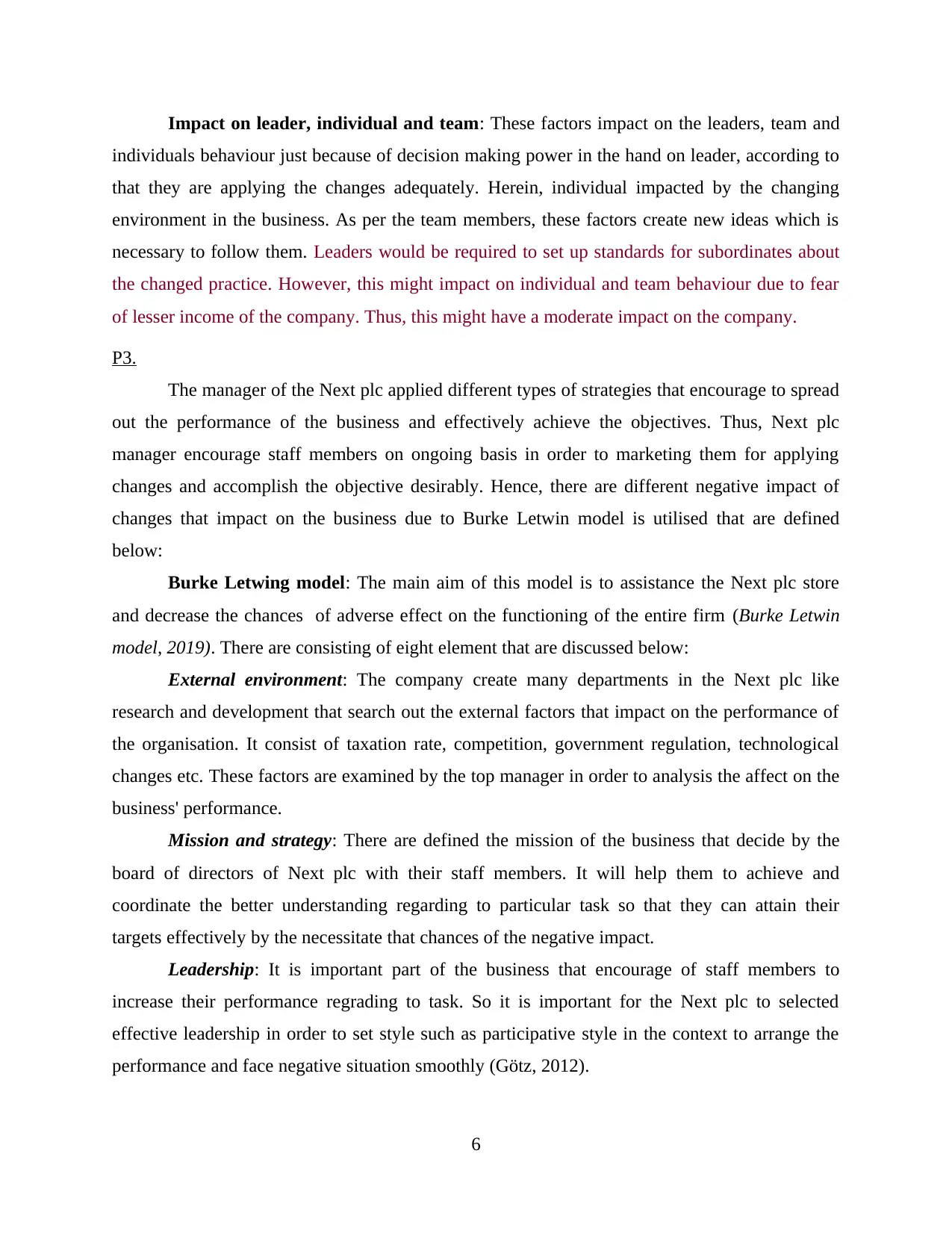
Impact on leader, individual and team: These factors impact on the leaders, team and
individuals behaviour just because of decision making power in the hand on leader, according to
that they are applying the changes adequately. Herein, individual impacted by the changing
environment in the business. As per the team members, these factors create new ideas which is
necessary to follow them. Leaders would be required to set up standards for subordinates about
the changed practice. However, this might impact on individual and team behaviour due to fear
of lesser income of the company. Thus, this might have a moderate impact on the company.
P3.
The manager of the Next plc applied different types of strategies that encourage to spread
out the performance of the business and effectively achieve the objectives. Thus, Next plc
manager encourage staff members on ongoing basis in order to marketing them for applying
changes and accomplish the objective desirably. Hence, there are different negative impact of
changes that impact on the business due to Burke Letwin model is utilised that are defined
below:
Burke Letwing model: The main aim of this model is to assistance the Next plc store
and decrease the chances of adverse effect on the functioning of the entire firm (Burke Letwin
model, 2019). There are consisting of eight element that are discussed below:
External environment: The company create many departments in the Next plc like
research and development that search out the external factors that impact on the performance of
the organisation. It consist of taxation rate, competition, government regulation, technological
changes etc. These factors are examined by the top manager in order to analysis the affect on the
business' performance.
Mission and strategy: There are defined the mission of the business that decide by the
board of directors of Next plc with their staff members. It will help them to achieve and
coordinate the better understanding regarding to particular task so that they can attain their
targets effectively by the necessitate that chances of the negative impact.
Leadership: It is important part of the business that encourage of staff members to
increase their performance regrading to task. So it is important for the Next plc to selected
effective leadership in order to set style such as participative style in the context to arrange the
performance and face negative situation smoothly (Götz, 2012).
6
individuals behaviour just because of decision making power in the hand on leader, according to
that they are applying the changes adequately. Herein, individual impacted by the changing
environment in the business. As per the team members, these factors create new ideas which is
necessary to follow them. Leaders would be required to set up standards for subordinates about
the changed practice. However, this might impact on individual and team behaviour due to fear
of lesser income of the company. Thus, this might have a moderate impact on the company.
P3.
The manager of the Next plc applied different types of strategies that encourage to spread
out the performance of the business and effectively achieve the objectives. Thus, Next plc
manager encourage staff members on ongoing basis in order to marketing them for applying
changes and accomplish the objective desirably. Hence, there are different negative impact of
changes that impact on the business due to Burke Letwin model is utilised that are defined
below:
Burke Letwing model: The main aim of this model is to assistance the Next plc store
and decrease the chances of adverse effect on the functioning of the entire firm (Burke Letwin
model, 2019). There are consisting of eight element that are discussed below:
External environment: The company create many departments in the Next plc like
research and development that search out the external factors that impact on the performance of
the organisation. It consist of taxation rate, competition, government regulation, technological
changes etc. These factors are examined by the top manager in order to analysis the affect on the
business' performance.
Mission and strategy: There are defined the mission of the business that decide by the
board of directors of Next plc with their staff members. It will help them to achieve and
coordinate the better understanding regarding to particular task so that they can attain their
targets effectively by the necessitate that chances of the negative impact.
Leadership: It is important part of the business that encourage of staff members to
increase their performance regrading to task. So it is important for the Next plc to selected
effective leadership in order to set style such as participative style in the context to arrange the
performance and face negative situation smoothly (Götz, 2012).
6
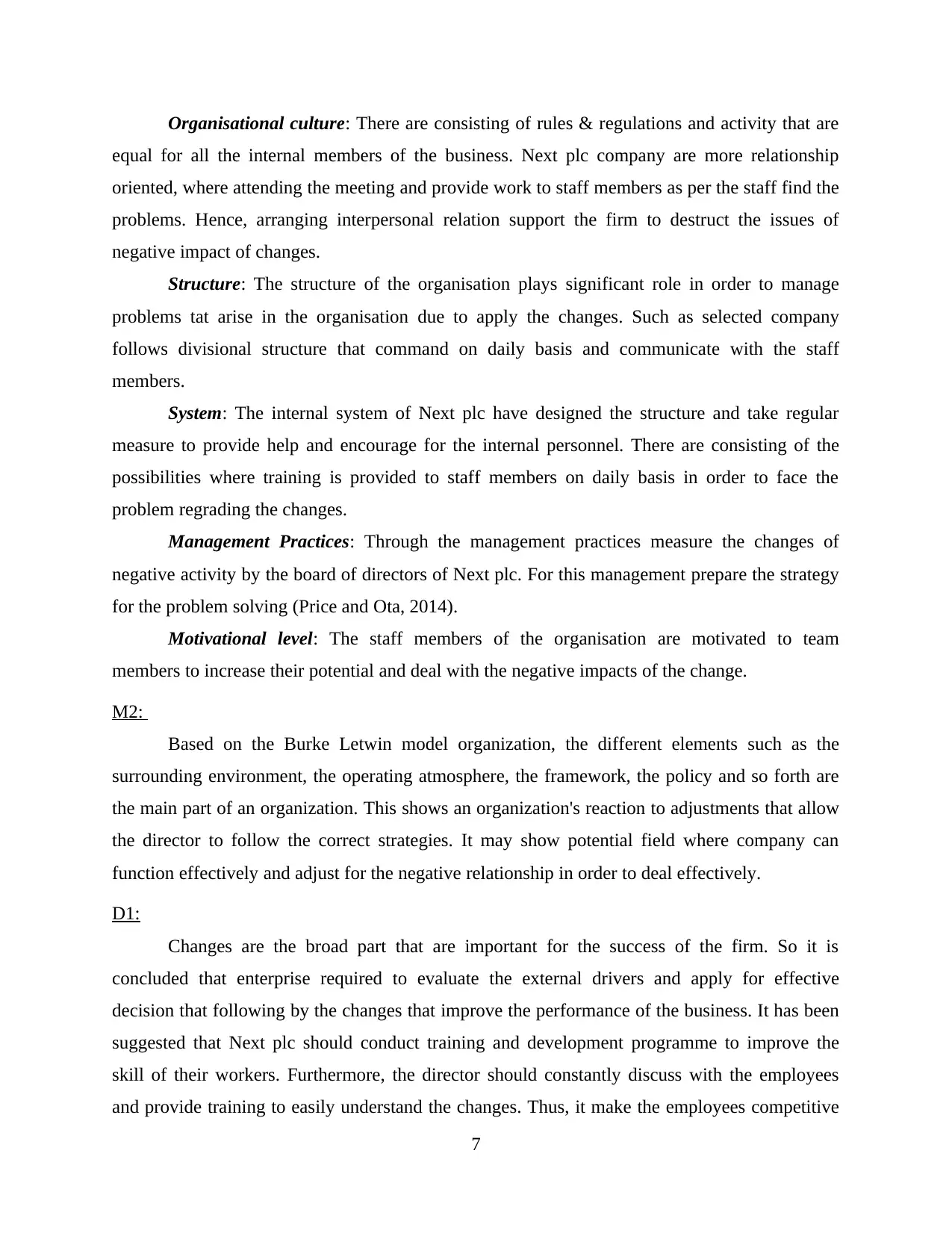
Organisational culture: There are consisting of rules & regulations and activity that are
equal for all the internal members of the business. Next plc company are more relationship
oriented, where attending the meeting and provide work to staff members as per the staff find the
problems. Hence, arranging interpersonal relation support the firm to destruct the issues of
negative impact of changes.
Structure: The structure of the organisation plays significant role in order to manage
problems tat arise in the organisation due to apply the changes. Such as selected company
follows divisional structure that command on daily basis and communicate with the staff
members.
System: The internal system of Next plc have designed the structure and take regular
measure to provide help and encourage for the internal personnel. There are consisting of the
possibilities where training is provided to staff members on daily basis in order to face the
problem regrading the changes.
Management Practices: Through the management practices measure the changes of
negative activity by the board of directors of Next plc. For this management prepare the strategy
for the problem solving (Price and Ota, 2014).
Motivational level: The staff members of the organisation are motivated to team
members to increase their potential and deal with the negative impacts of the change.
M2:
Based on the Burke Letwin model organization, the different elements such as the
surrounding environment, the operating atmosphere, the framework, the policy and so forth are
the main part of an organization. This shows an organization's reaction to adjustments that allow
the director to follow the correct strategies. It may show potential field where company can
function effectively and adjust for the negative relationship in order to deal effectively.
D1:
Changes are the broad part that are important for the success of the firm. So it is
concluded that enterprise required to evaluate the external drivers and apply for effective
decision that following by the changes that improve the performance of the business. It has been
suggested that Next plc should conduct training and development programme to improve the
skill of their workers. Furthermore, the director should constantly discuss with the employees
and provide training to easily understand the changes. Thus, it make the employees competitive
7
equal for all the internal members of the business. Next plc company are more relationship
oriented, where attending the meeting and provide work to staff members as per the staff find the
problems. Hence, arranging interpersonal relation support the firm to destruct the issues of
negative impact of changes.
Structure: The structure of the organisation plays significant role in order to manage
problems tat arise in the organisation due to apply the changes. Such as selected company
follows divisional structure that command on daily basis and communicate with the staff
members.
System: The internal system of Next plc have designed the structure and take regular
measure to provide help and encourage for the internal personnel. There are consisting of the
possibilities where training is provided to staff members on daily basis in order to face the
problem regrading the changes.
Management Practices: Through the management practices measure the changes of
negative activity by the board of directors of Next plc. For this management prepare the strategy
for the problem solving (Price and Ota, 2014).
Motivational level: The staff members of the organisation are motivated to team
members to increase their potential and deal with the negative impacts of the change.
M2:
Based on the Burke Letwin model organization, the different elements such as the
surrounding environment, the operating atmosphere, the framework, the policy and so forth are
the main part of an organization. This shows an organization's reaction to adjustments that allow
the director to follow the correct strategies. It may show potential field where company can
function effectively and adjust for the negative relationship in order to deal effectively.
D1:
Changes are the broad part that are important for the success of the firm. So it is
concluded that enterprise required to evaluate the external drivers and apply for effective
decision that following by the changes that improve the performance of the business. It has been
suggested that Next plc should conduct training and development programme to improve the
skill of their workers. Furthermore, the director should constantly discuss with the employees
and provide training to easily understand the changes. Thus, it make the employees competitive
7
⊘ This is a preview!⊘
Do you want full access?
Subscribe today to unlock all pages.

Trusted by 1+ million students worldwide
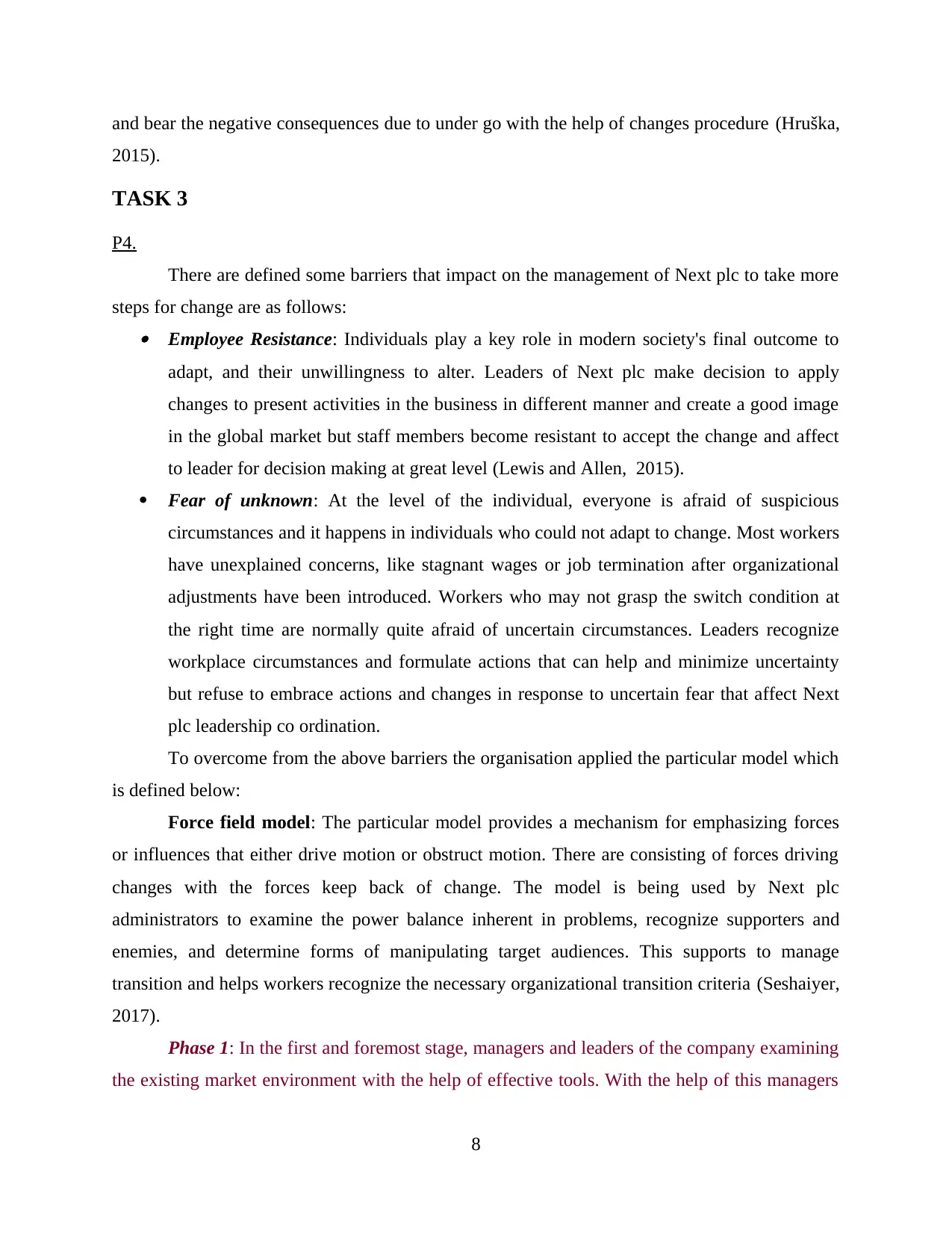
and bear the negative consequences due to under go with the help of changes procedure (Hruška,
2015).
TASK 3
P4.
There are defined some barriers that impact on the management of Next plc to take more
steps for change are as follows: Employee Resistance: Individuals play a key role in modern society's final outcome to
adapt, and their unwillingness to alter. Leaders of Next plc make decision to apply
changes to present activities in the business in different manner and create a good image
in the global market but staff members become resistant to accept the change and affect
to leader for decision making at great level (Lewis and Allen, 2015).
Fear of unknown: At the level of the individual, everyone is afraid of suspicious
circumstances and it happens in individuals who could not adapt to change. Most workers
have unexplained concerns, like stagnant wages or job termination after organizational
adjustments have been introduced. Workers who may not grasp the switch condition at
the right time are normally quite afraid of uncertain circumstances. Leaders recognize
workplace circumstances and formulate actions that can help and minimize uncertainty
but refuse to embrace actions and changes in response to uncertain fear that affect Next
plc leadership co ordination.
To overcome from the above barriers the organisation applied the particular model which
is defined below:
Force field model: The particular model provides a mechanism for emphasizing forces
or influences that either drive motion or obstruct motion. There are consisting of forces driving
changes with the forces keep back of change. The model is being used by Next plc
administrators to examine the power balance inherent in problems, recognize supporters and
enemies, and determine forms of manipulating target audiences. This supports to manage
transition and helps workers recognize the necessary organizational transition criteria (Seshaiyer,
2017).
Phase 1: In the first and foremost stage, managers and leaders of the company examining
the existing market environment with the help of effective tools. With the help of this managers
8
2015).
TASK 3
P4.
There are defined some barriers that impact on the management of Next plc to take more
steps for change are as follows: Employee Resistance: Individuals play a key role in modern society's final outcome to
adapt, and their unwillingness to alter. Leaders of Next plc make decision to apply
changes to present activities in the business in different manner and create a good image
in the global market but staff members become resistant to accept the change and affect
to leader for decision making at great level (Lewis and Allen, 2015).
Fear of unknown: At the level of the individual, everyone is afraid of suspicious
circumstances and it happens in individuals who could not adapt to change. Most workers
have unexplained concerns, like stagnant wages or job termination after organizational
adjustments have been introduced. Workers who may not grasp the switch condition at
the right time are normally quite afraid of uncertain circumstances. Leaders recognize
workplace circumstances and formulate actions that can help and minimize uncertainty
but refuse to embrace actions and changes in response to uncertain fear that affect Next
plc leadership co ordination.
To overcome from the above barriers the organisation applied the particular model which
is defined below:
Force field model: The particular model provides a mechanism for emphasizing forces
or influences that either drive motion or obstruct motion. There are consisting of forces driving
changes with the forces keep back of change. The model is being used by Next plc
administrators to examine the power balance inherent in problems, recognize supporters and
enemies, and determine forms of manipulating target audiences. This supports to manage
transition and helps workers recognize the necessary organizational transition criteria (Seshaiyer,
2017).
Phase 1: In the first and foremost stage, managers and leaders of the company examining
the existing market environment with the help of effective tools. With the help of this managers
8
Paraphrase This Document
Need a fresh take? Get an instant paraphrase of this document with our AI Paraphraser
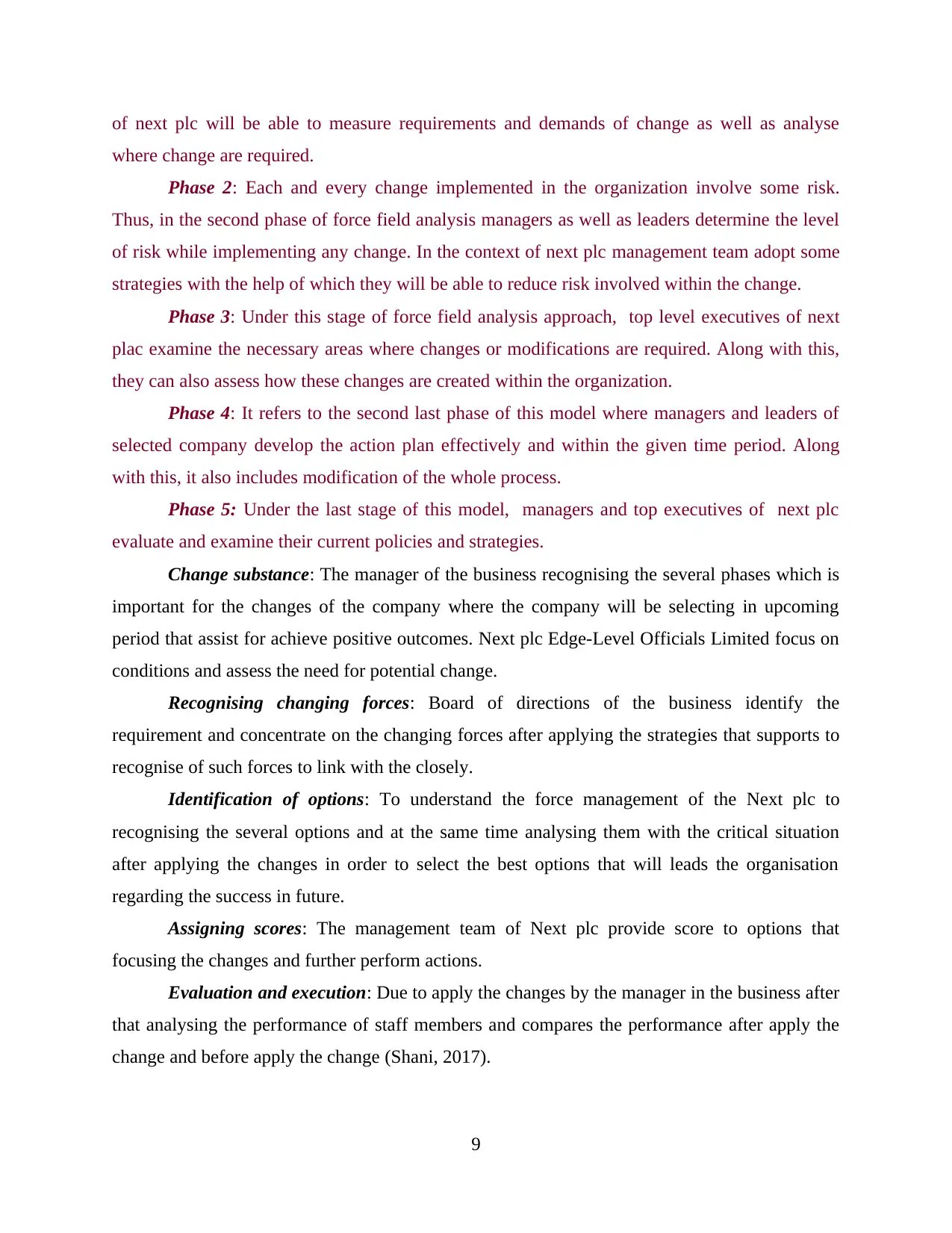
of next plc will be able to measure requirements and demands of change as well as analyse
where change are required.
Phase 2: Each and every change implemented in the organization involve some risk.
Thus, in the second phase of force field analysis managers as well as leaders determine the level
of risk while implementing any change. In the context of next plc management team adopt some
strategies with the help of which they will be able to reduce risk involved within the change.
Phase 3: Under this stage of force field analysis approach, top level executives of next
plac examine the necessary areas where changes or modifications are required. Along with this,
they can also assess how these changes are created within the organization.
Phase 4: It refers to the second last phase of this model where managers and leaders of
selected company develop the action plan effectively and within the given time period. Along
with this, it also includes modification of the whole process.
Phase 5: Under the last stage of this model, managers and top executives of next plc
evaluate and examine their current policies and strategies.
Change substance: The manager of the business recognising the several phases which is
important for the changes of the company where the company will be selecting in upcoming
period that assist for achieve positive outcomes. Next plc Edge-Level Officials Limited focus on
conditions and assess the need for potential change.
Recognising changing forces: Board of directions of the business identify the
requirement and concentrate on the changing forces after applying the strategies that supports to
recognise of such forces to link with the closely.
Identification of options: To understand the force management of the Next plc to
recognising the several options and at the same time analysing them with the critical situation
after applying the changes in order to select the best options that will leads the organisation
regarding the success in future.
Assigning scores: The management team of Next plc provide score to options that
focusing the changes and further perform actions.
Evaluation and execution: Due to apply the changes by the manager in the business after
that analysing the performance of staff members and compares the performance after apply the
change and before apply the change (Shani, 2017).
9
where change are required.
Phase 2: Each and every change implemented in the organization involve some risk.
Thus, in the second phase of force field analysis managers as well as leaders determine the level
of risk while implementing any change. In the context of next plc management team adopt some
strategies with the help of which they will be able to reduce risk involved within the change.
Phase 3: Under this stage of force field analysis approach, top level executives of next
plac examine the necessary areas where changes or modifications are required. Along with this,
they can also assess how these changes are created within the organization.
Phase 4: It refers to the second last phase of this model where managers and leaders of
selected company develop the action plan effectively and within the given time period. Along
with this, it also includes modification of the whole process.
Phase 5: Under the last stage of this model, managers and top executives of next plc
evaluate and examine their current policies and strategies.
Change substance: The manager of the business recognising the several phases which is
important for the changes of the company where the company will be selecting in upcoming
period that assist for achieve positive outcomes. Next plc Edge-Level Officials Limited focus on
conditions and assess the need for potential change.
Recognising changing forces: Board of directions of the business identify the
requirement and concentrate on the changing forces after applying the strategies that supports to
recognise of such forces to link with the closely.
Identification of options: To understand the force management of the Next plc to
recognising the several options and at the same time analysing them with the critical situation
after applying the changes in order to select the best options that will leads the organisation
regarding the success in future.
Assigning scores: The management team of Next plc provide score to options that
focusing the changes and further perform actions.
Evaluation and execution: Due to apply the changes by the manager in the business after
that analysing the performance of staff members and compares the performance after apply the
change and before apply the change (Shani, 2017).
9
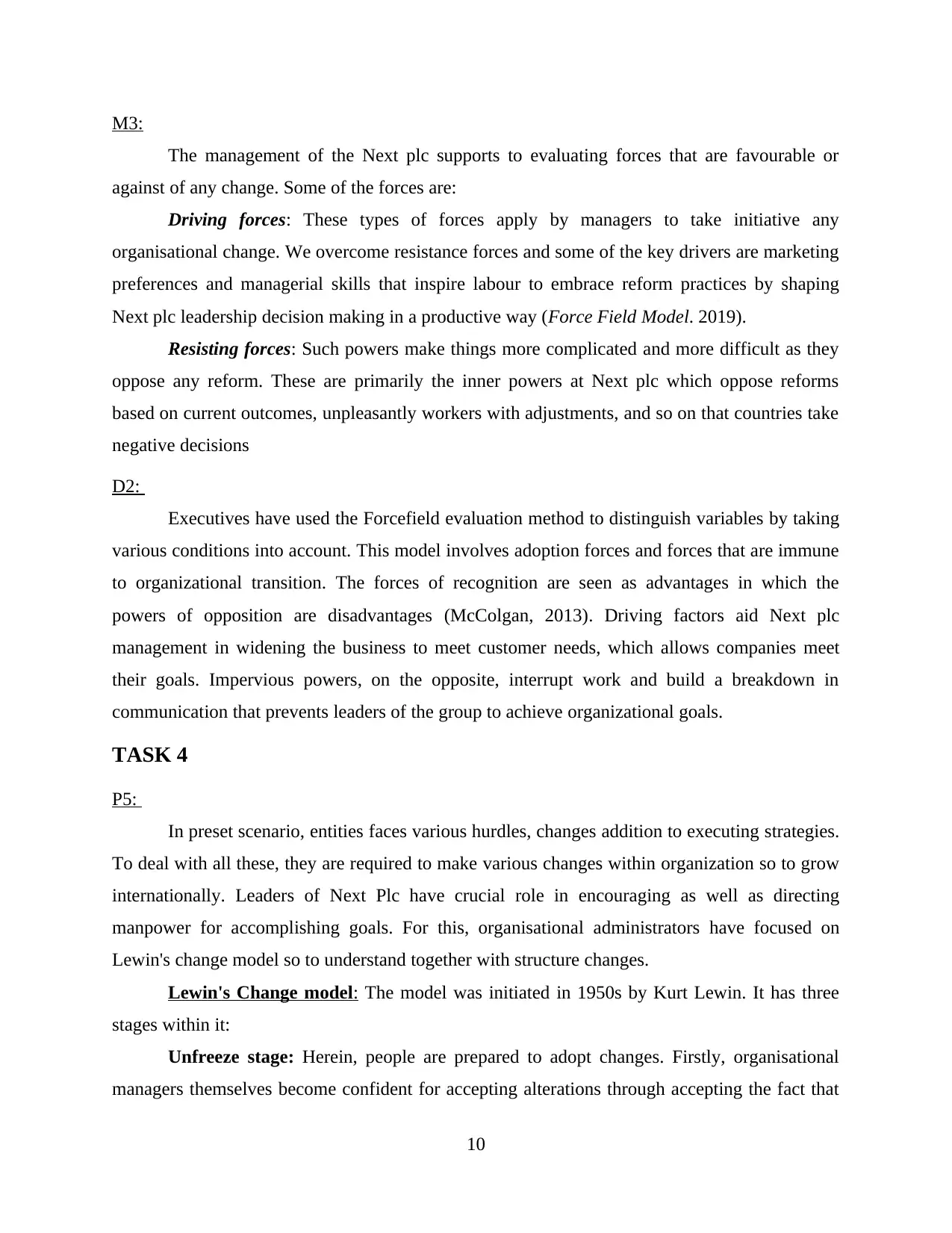
M3:
The management of the Next plc supports to evaluating forces that are favourable or
against of any change. Some of the forces are:
Driving forces: These types of forces apply by managers to take initiative any
organisational change. We overcome resistance forces and some of the key drivers are marketing
preferences and managerial skills that inspire labour to embrace reform practices by shaping
Next plc leadership decision making in a productive way (Force Field Model. 2019).
Resisting forces: Such powers make things more complicated and more difficult as they
oppose any reform. These are primarily the inner powers at Next plc which oppose reforms
based on current outcomes, unpleasantly workers with adjustments, and so on that countries take
negative decisions
D2:
Executives have used the Forcefield evaluation method to distinguish variables by taking
various conditions into account. This model involves adoption forces and forces that are immune
to organizational transition. The forces of recognition are seen as advantages in which the
powers of opposition are disadvantages (McColgan, 2013). Driving factors aid Next plc
management in widening the business to meet customer needs, which allows companies meet
their goals. Impervious powers, on the opposite, interrupt work and build a breakdown in
communication that prevents leaders of the group to achieve organizational goals.
TASK 4
P5:
In preset scenario, entities faces various hurdles, changes addition to executing strategies.
To deal with all these, they are required to make various changes within organization so to grow
internationally. Leaders of Next Plc have crucial role in encouraging as well as directing
manpower for accomplishing goals. For this, organisational administrators have focused on
Lewin's change model so to understand together with structure changes.
Lewin's Change model: The model was initiated in 1950s by Kurt Lewin. It has three
stages within it:
Unfreeze stage: Herein, people are prepared to adopt changes. Firstly, organisational
managers themselves become confident for accepting alterations through accepting the fact that
10
The management of the Next plc supports to evaluating forces that are favourable or
against of any change. Some of the forces are:
Driving forces: These types of forces apply by managers to take initiative any
organisational change. We overcome resistance forces and some of the key drivers are marketing
preferences and managerial skills that inspire labour to embrace reform practices by shaping
Next plc leadership decision making in a productive way (Force Field Model. 2019).
Resisting forces: Such powers make things more complicated and more difficult as they
oppose any reform. These are primarily the inner powers at Next plc which oppose reforms
based on current outcomes, unpleasantly workers with adjustments, and so on that countries take
negative decisions
D2:
Executives have used the Forcefield evaluation method to distinguish variables by taking
various conditions into account. This model involves adoption forces and forces that are immune
to organizational transition. The forces of recognition are seen as advantages in which the
powers of opposition are disadvantages (McColgan, 2013). Driving factors aid Next plc
management in widening the business to meet customer needs, which allows companies meet
their goals. Impervious powers, on the opposite, interrupt work and build a breakdown in
communication that prevents leaders of the group to achieve organizational goals.
TASK 4
P5:
In preset scenario, entities faces various hurdles, changes addition to executing strategies.
To deal with all these, they are required to make various changes within organization so to grow
internationally. Leaders of Next Plc have crucial role in encouraging as well as directing
manpower for accomplishing goals. For this, organisational administrators have focused on
Lewin's change model so to understand together with structure changes.
Lewin's Change model: The model was initiated in 1950s by Kurt Lewin. It has three
stages within it:
Unfreeze stage: Herein, people are prepared to adopt changes. Firstly, organisational
managers themselves become confident for accepting alterations through accepting the fact that
10
⊘ This is a preview!⊘
Do you want full access?
Subscribe today to unlock all pages.

Trusted by 1+ million students worldwide
1 out of 17
Related Documents
Your All-in-One AI-Powered Toolkit for Academic Success.
+13062052269
info@desklib.com
Available 24*7 on WhatsApp / Email
![[object Object]](/_next/static/media/star-bottom.7253800d.svg)
Unlock your academic potential
Copyright © 2020–2025 A2Z Services. All Rights Reserved. Developed and managed by ZUCOL.





